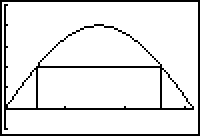The following questions illustrate the procedure used to find the rectangle inscribed under the graph of f(x) = sin x in the first quadrant on the interval [0,
![]() ] that has maximum area. Here x stands for the x-coordinate of the lower left corner of the rectangle. The area of a rectangle is A = hw, where h and w are the height and width of the rectangle, respectively.
] that has maximum area. Here x stands for the x-coordinate of the lower left corner of the rectangle. The area of a rectangle is A = hw, where h and w are the height and width of the rectangle, respectively.

- Define the height as a function of x.
-
Define the width as a function of x. (Hint: Use the symmetry of the rectangle's base in the interval [0,
 ].)
].)
- Enter the height, width and area functions in Y1, Y2 and Y3 of the Y= editor of your TI-83. Unselect Y1 and Y2.
- Define the derivative of the area function in Y4.
- Graph the area function and its derivative. Describe the correspondence between the derivative and the maximum of the function.
-
Find the zeros of the derivative on the interval
 .
.
- Verify that the critical point found in Question 5 produces the absolute maximum of the area function and find the maximum area of the rectangle.
Click here to check your answers.